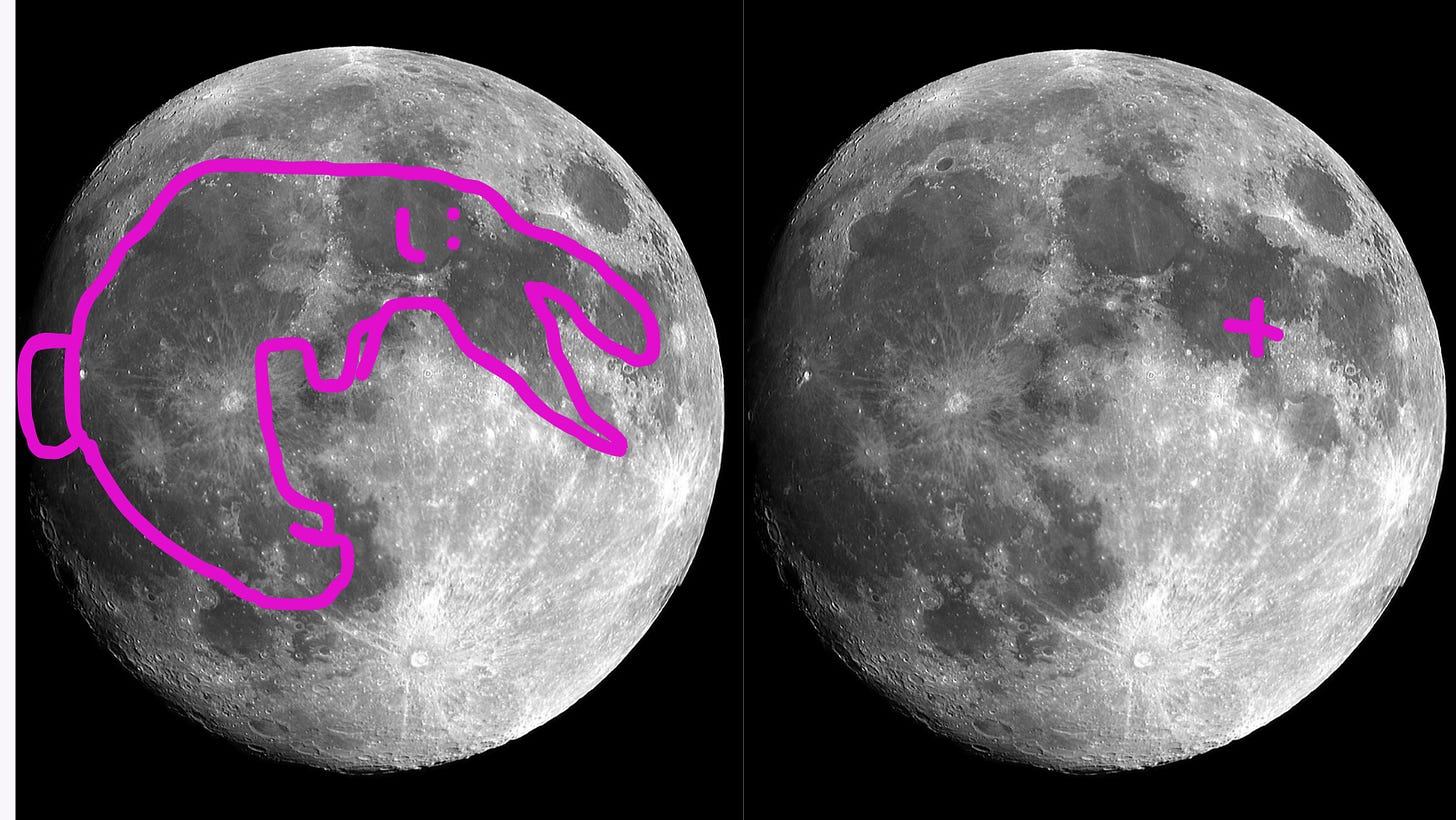The Moon Part 2: The legend of the rabbit
A success story about a rabbit's lack of survival instinct
This is Part 2 of a series of articles about the Moon. In Part 1, we questioned the Moon’s influence on women’s menstrual cycle. This time, we are going to talk about another popular Mexican legend, and if we know something about Mexican legends by now, it’s that the lessons they try to teach us have questionable logic for our modern days. The tale you are about to read is no exception to this rule.
At some point in our relationship, I asked my non-Mexican-born partner if whenever he looked up at the moon, he also saw the profile of a rabbit, and whether his culture had any tale about what I thought was a very distinctive and recognizable shape in the sky. He answered that the only thing he saw was human ingenuity at its best, reminded of the fact that humankind was capable to travel and step foot onto this satellite planet (boring!). Appalled, I began telling him the tale about the rabbit in the moon, a story I learned in elementary school.
To the left: The rabbit I see when I look at the moon. To the right: The place where I think men stepped on the moon.
But first, some context. Based on the articles that I read I cannot pinpoint the exact origin of this legend, but most of the sources say that the tale comes from the Aztecs, a Mesoamerican civilization that spoke Nahuatl and lived in central Mexico during the 14th to 17th centuries. One of the most important Gods of the time was Quetzalcoatl (pronounced KETchup-coATTel), also known as the feathered serpent. Quetzalcoatl represented the body/spirit duality of humans, and he was also known as the deity that reigned over the wind and rain.
One day, Quetzalcoatl was bored with his heavenly life, so he decided that he wanted to take a walk on Earth to see what was buzzing. He descended from heaven and began his hike into humanly populated terrains. He was marveled by the green and vast fields, the blueness and depth of lakes, and the majestic beauty of the mountains he encountered. He walked a long time and then he thought “Hmm. It seems like I am hungry.” But to no woman’s surprise, he did not think of packing food before he left heaven. Where was his tote bag with allergy pills, snacks, a bottle of water (or whatever Gods drank at the time), band-aids, moisturizer, and lip balm? NOWHERE.
First lesson of this story: plan ahead and carry the basics for a trip of this nature.
Anyhow, he sat down in the grass while his heavenly stomach rumbled due to its emptiness, when a rabbit passed by. Quetzalcoatl asked him, “Little bunny what are you eating?” To which the rabbit answered “I am eating grass and carrots, they are so tasty yum. Do you want some?” Quetzalcoatl simply answered “Oh no, I cannot possibly take a living being’s sustenance, that would be too selfish of me! I guess I will just stay here and starve to death.”
Second lesson of the story: maybe don’t give up so easily in life?
But the lack of common sense and intelligence of our characters did not stop there. The rabbit, all filled with innocence and cuteness answered “Oh, You cannot just starve to death! Listen, I am just a little and humble rabbit in this universe, please eat me! Use my body to appease your hunger.”
Third lesson: KNOW YOUR WORTH!
Without thinking twice, Quetzalcoatl took the rabbit and ate it.
LOL just kidding. After hearing that the rabbit was willing to sacrifice itself to help Quetzalcoatl survive and overcome his lack of planning and initiative, the God was moved to tears. Instead of eating the rabbit, he decided to award his altruistic nature with a trip to the stars. Quetzalcoatl took him so close to the moon that the rabbit’s profile was forever imprinted on the surface. And that is the reason every time you look into a full moon, you will see that rabbit silhouette, to remind you that life-threatening generosity can get you an eternal legacy.
What a rollercoaster of a tale. Please carry snacks on your next hike!









